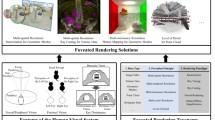Abstract
In this contribution we studied how different rendering styles of a virtual human impacted users’ visual attention in an interactive medical training simulator. In a mixed design experiment, 78 participants interacted with a virtual human representing a sample from the non-photorealistic (NPR) to the photorealistic (PR) rendering continuity. We presented five rendering style samples scenarios, namely All Pencil Shaded (APS), Pencil Shaded (PS), All Cartoon Shaded (ACT), Cartoon Shaded (CT), and Human-Like (HL), and compared how visual attention differed between groups of users. For this study, we employed an eye tracking system for collecting and analyzing users’ gaze during interaction with the virtual human in a failure to rescue medical training simulation. Results shows that users spent more total time in the APS and ACT conditions but users visually attended more to virtual humans in the PS, CT and HL appearance conditions.













Similar content being viewed by others
References
Ayush B, Bertrand JW, Gramopadhye AK, Madathil KC, Babu SV (2018) Evaluating multiple levels of an interaction fidelity continuum on performance and learning in near-field training simulations. IEEE Trans Vis Comput Gr 24(4):1418–1427
Brenton H, Gillies M, Ballin D, Chatting D (2005) The uncanny valley: does it exist. In: Proceedings of conference of human computer interaction, workshop on human animated character interaction
Carter EJ, Mahler M, Hodgins JK (2013) Unpleasantness of animated characters corresponds to increased viewer attention to faces. In: Proceedings of the ACM Symposium on Applied Perception, pp. 35-40
Debevec P (2012) The light stages and their applications to photoreal digital actors. SIGGRAPH Asia 2(4):1–6
Debevec P(2000) Acquiring the reflectance field of a human face. In: Proceedings of the 27th annual conference on computer graphics and interactive techniques, pp 145–156
Duchowski A (2007) Eye tracking methodology: theory and practice, vol 328, no 614. Springer, pp 2–3
Halper N, Mellin M, Duke D, Strothotte T (2003) Implicational rendering: drawing on latent human knowledge. ACM Trans Appl Percept
Halper N, Mellin M, Herrmann CS, Linneweber V, Strothotte T (2003) Psychology and non-photorealistic rendering: The beginning of a beautiful relationship. Mensch & Computer 2003. Springer, pp 277–286
Hoffman D D (2000) Visual intelligence: how we create what we see. WW Norton and Company
Hu L, Bentler PM (1999) Cutoff criteria for fit indexes in covariance structure analysis: conventional criteria versus new alternatives. Struct Equ Model Multidiscip J 6(1):1–55
Gooch AA, Long J, Ji L, Estey A, Gooch BS (2003) Viewing progress in non-photorealistic rendering through Heinlein’s lens. ACM 1:165–171
Lake A, Marshall C, Harris M, Blackstein M (2000) Stylized rendering techniques for scalable real-time 3d animation. In: Proceedings of the 1st international symposium on non-photorealistic animation and rendering, pp 13–20
MacDorman KF (2006) Subjective ratings of robot video clips for human likeness, familiarity, and eeriness: an exploration of the uncanny valley. In: ICCS/CogSci long symposium, pp 26–29
MacDorman KF, Green RD, Ho CC, Koch CT (2009) Too real for comfort? Uncanny responses to computer generated faces. Comput Human Behav 25(3):695–710
Masuch M, Röber, N (2004) Game graphics beyond realism: then, now and tomorrow. In: Level UP: digital games research conference. DIGRA, Faculty of Arts, University of Utrecht
McDonnell R, Breidt M, Bulthoff HH (2012) Render me real?: investigating the effect of render style on the perception of animated virtual humans. ACM Trans Gr 31(4):91
McMahan RP, Bowman DA, Zielinski DJ, Brady RB (2012) Evaluating display fidelity and interaction fidelity in a virtual reality game. IEEE Trans Vis Comput Gr 18(4):626–633
Mori M (2012) The uncanny valley. IEEE Robot Autom Mag 19(2):98–100
Niles HE (1922) Correlation, causation and Wright’s theory of path coefficients. Genetics 7(3):258
Nystrom M, Holmqvist K (2010) An adaptive algorithm for fixation, saccade, and glissade detection in eyetracking data. Behav Res Methods 42(1):188–204
Salvucci DD, Goldberg JH (2000) Identifying fixations and saccades in eye-tracking protocols. In: Proceedings of the 2000 symposium on Eye tracking research and applications, pp 71–78
Seyama J, Nagayama RS (2007) The uncanny valley: effect of realism on the impression of artificial human faces. Presence Teleoperators Virtual Environ 16(4):337–351
Volonte M, Anaraky RG, Knijnenburg B, Duchowski AT, Babu SV (2019) Empirical evaluation of the interplay of emotion and visual attention in human-virtual human interaction, pp 1–9
Volante M, Babu SV, Chaturvedi H, Newsome N, Ebrahimi E, Roy T, Daily SB, Fasolino T (2016) Effects of virtual human appearance fidelity on emotion contagion in affective inter-personal simulations. IEEE Trans Visual Comput Graphics 22(4): 1326–1335
Zibrek K, McDonnell R (2014) Does render style affect perception of personality in virtual humans? In: Proceedings of the ACM symposium on applied perception, pp 111–115
Author information
Authors and Affiliations
Corresponding author
Additional information
Publisher's Note
Springer Nature remains neutral with regard to jurisdictional claims in published maps and institutional affiliations.
Rights and permissions
About this article
Cite this article
Volonte, M., Anaraky, R.G., Venkatakrishnan, R. et al. Empirical evaluation and pathway modeling of visual attention to virtual humans in an appearance fidelity continuum. J Multimodal User Interfaces 15, 109–119 (2021). https://doi.org/10.1007/s12193-020-00341-z
Received:
Accepted:
Published:
Issue Date:
DOI: https://doi.org/10.1007/s12193-020-00341-z




